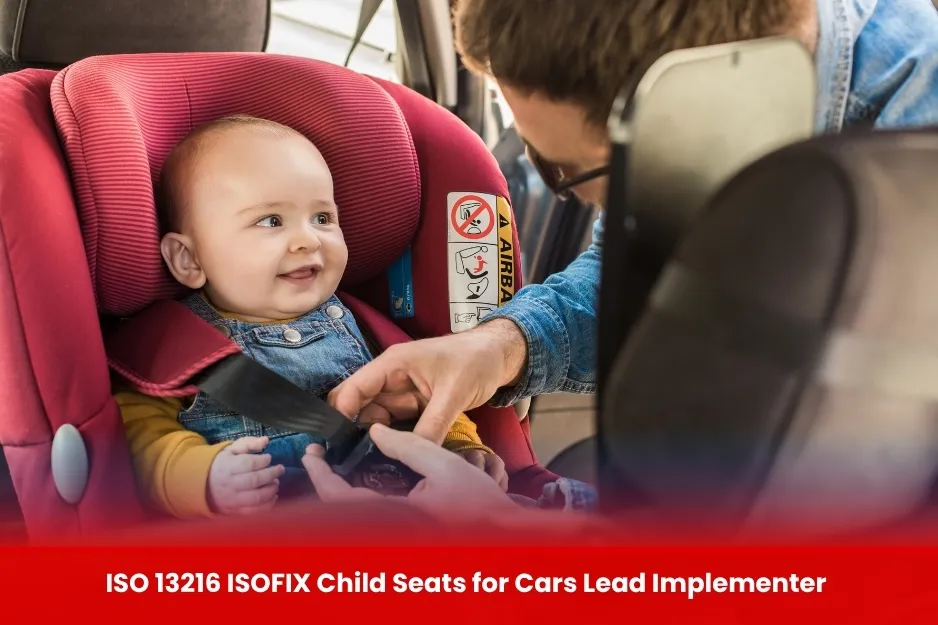ISO 13216 ISOFIX Child Seats for Cars Lead Implementer
ISO 13216 is the international standard that defines the design and installation of ISOFIX anchorage systems in cars — a system that ensures safe, secure, and standardized attachment of child car seats in vehicles.
Incorrect installation of child seats is one of the major causes of injuries in vehicle accidents. ISOFIX solves this problem by providing fixed mounting points, making child seat installation easier, faster, and safer.
The ISO 13216 Lead Implementer role involves leading the implementation, compliance, and integration of ISOFIX systems in the design, production, and testing of vehicles and child restraint systems.

Aim of ISO 13216 ISOFIX Child Seats for Cars Lead Implementer
The aim of this program is to equip professionals with the technical knowledge, practical skills, and leadership capability required to successfully implement and manage ISO 13216 (ISOFIX) anchorage systems in vehicles, ensuring compliance with international child safety standards.
Course Overview
ISO 13216 ISOFIX Child Seats for Cars Lead Implementer
- Educational Background
- A degree or diploma in Automotive Engineering, Mechanical Engineering, Product Design, Vehicle Safety, or related technical fields.
- Equivalent practical experience in the automotive industry may also be accepted.
- Professional Experience
- Minimum 2–3 years of experience in automotive manufacturing, vehicle safety, quality assurance, or child restraint system (CRS) development.
- Familiarity with automotive design, compliance, or regulatory standards is preferred.
- Technical Knowledge (Preferred)
- Basic understanding of vehicle safety systems, ISOFIX mechanisms, or child seat anchorage design.
Prior exposure to standards like ISO 13216, UNECE R44, R129, or FMVSS 213 is advantageous.
| Course Code | Curriculum Title | Credit | DLH |
|---|---|---|---|
| BUK1970-1 | Introduction to ISO 13216 and ISOFIX System | 2 | 10 |
| BUK1970-2 | Auditing and Continuous Improvement | 2 | 10 |
| BUK1970-3 | Understanding ISO 13216-1 and ISO 13216-2 Standards | 2 | 10 |
| BUK1970-4 | Regulatory Frameworks and Compliance | 2 | 10 |
| BUK1970-5 | Design & Integration of ISOFIX Systems | 2 | 10 |
| BUK1970-6 | Auditing and Continuous Improvement | 2 | 10 |
Module 1: Introduction to ISO 13216 and ISOFIX System
- Overview of ISO 13216 Part 1 and Part 2
- History and evolution of ISOFIX
- Importance of child restraint safety in vehicles
- Relationship with other safety standards (UNECE R44, R129, FMVSS 213)
Module 2: Understanding ISO 13216-1 and ISO 13216-2 Standards
- Technical specifications for lower anchorage systems (Part 1)
- Top tether anchorages (Part 2)
- ISOFIX categories (universal, semi-universal, vehicle-specific)
- Geometry and strength requirements
Module 3: Regulatory Frameworks and Compliance
- Global regulations affecting child seats and ISOFIX (UNECE, FMVSS, etc.)
- Legal compliance vs. voluntary standards
- Alignment with vehicle homologation and type approval processes
Module 4: Design & Integration of ISOFIX Systems
- Integrating ISOFIX into vehicle seat and chassis design
- Collaboration with CRS (child seat) manufacturers
- Compatibility testing and virtual simulation
- CAD & tolerance planning
Module 5: Implementation Planning and Project Management
- Steps in planning an ISOFIX implementation project
- Gap analysis and current state assessment
- Cross-functional implementation teams
- Timeline, resource allocation, and risk management
Module 6: Testing, Validation, and Quality Control
- Static and dynamic testing methods
- Load-bearing, crash simulation, and safety validation
- Quality assurance and manufacturing controls
- Working with test labs and certification bodies
Module 7: Documentation and Technical File Preparation
- Required documentation under ISO 13216
- Drawing packages, installation instructions, user manuals
- Regulatory submission documents and audit readiness
Module 8: Auditing and Continuous Improvement
- Conducting internal and supplier audits
- Corrective actions and design improvements
- Monitoring field performance and feedback loops
Module 9: Integration with Management Systems (Optional/Advanced)
- Aligning ISO 13216 implementation with ISO 9001 / IATF 16949
- Process approach and risk-based thinking
- Continual improvement and KPI tracking
- Automotive Industry Professionals
- Quality & Compliance Professionals
- CRS (Child Restraint System) Manufacturers
- OEMs and Tier 1/Tier 2 Suppliers
- Auditors and Consultants
- Other Interested Professionals
- All Modules within this qualification are assessed internally by the approved training Centre and externally verified by BURRAQ UK. The program uses a criterion-referenced assessment approach to ensure that learners successfully meet all required learning outcomes.
- A Pass in any unit is granted only when the learner submits valid, reliable, and authentic evidence that demonstrates achievement of the assessment criteria. The Assessor is responsible for reviewing this evidence and confirming that the learner has attained the expected standard.
